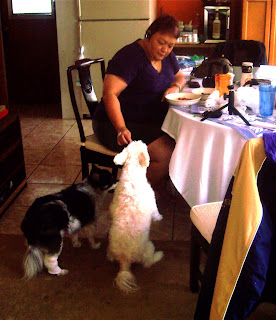
In 1964 I found myself living in Kowloon. It was part of Hong Kong, when that colony's return to China seemed somewhere in the abstract distant future. Like 1984, or 2001. TV in the British Crown Colony was called "Rediffusion." I had recently married Lenore Elliott (above) of Tacoma, Washington. A brief visit to her parents, a honeymoon in Tokyo and I was on assignment: to put a "pirate" radio station on the air from Macau, the small, Portuguese-ruled peninsula close by. We lived in an apartment called a "flat." The hot water heater was a "geyser," pronounced "geezer." All very Brit. The locals played cricket, rugby and ran their horse races clockwise. But the big game was football, or as we twisted Americans call it "Soccer ".
Saturday was the Eurocup Finals. It happens but once every four years. Like an American election, but with less buildup (when seriously analyzed.) Saturday's match was a doozy. The Europeans have it down. Pregame festivities were elegant and artsy. The venue was in Vienna, a city I was lucky enough to visit once. Teams are backed by entire countries and their citizens around the world. They have traditions that predate U. S. pro football's beginnings in the 1920a by decades. In Hong Kong I became a Manchester United fan before it was called "Man U." Before David Beckham was born. I've long ago conceded that "soccer" would not catch on as a great attraction on American TV. Those of us dumb enough to give a damn know all the
reasons.
But, like the Olympic Games, World Cup or U. S. Presidential Election, it's something that only happens 25 times a century, worth checking out for a few hours. Wow, what a game between underdog Spain and the German squad, going for an unprecedented fourth European championship. The way to watch high-level soccer is like this: (1) Keep your eye on the ball. This was the easiest ever Saturday, as the ball was silver. It showed up on my LG wide screen TV like a glistening chrome pinball. (2) Until someone scores a goal, the teams switch from offense to defense quicker than basketball. And, unlike the wimps who play that game, there are no time outs. When someone goes down from a shot to the face with an "accidental" elbow, for instance, the teams play on. Germany's captain was knocked out cold for a few minutes yesterday. He returned, blood dripping down his face, and almost tied the game, which would have forced overtime, in the closing minutes with an oh-so-close shot on goal.
The star of the affair was blond, big and fast Fernando Torres (below, GETTY IMAGES) whose only goal proved to be the winner. Sports journalism, when it comes to the real football is outright majestic. The LONDON TIMES described the shot that shook the soul of Spain thus: "The athleticism, and the determination to pursue every ball by Torres is well known to followers of his first club, Atletico Madrid, and now his second, Liverpool. So in the finality of his finish."
"On 33 minutes he a scored a goal that was the product of both. Why Germany's defenders--the biggest physical specimens in European soccer--went absent without leave presumably will bring an inquest after the event. But, too late.

"When Xavi Hernandez looked up and released the ball along the ground, he set up a race between Torres and the smallest German, Philipp Lahm. Torres had a meter to make up, and as he did so there was a momentary coming together in which the forward's hand was on the arm of the defender. The Italian referee, who seconds earlier had marvelously waived the advantage without stopping play after a German foul, was silent again.
"So on went Torres, out came Lehmann to the only place where a goalkeeper has a chance to cut down the angle of a forward's approach. Torres saw him, let the goalie dive, and immaculately drove the ball right-footed across the keeper and inside the far netting. A goal to savor from every respect."
The King of Spain, everyone in the huge stadium and all of the country of 40 million citizens went nuts. And, (3), Germany would now be on offense. To either score to tie or win. Or lose. Spain held on, in fact coming close to nailing it down several times in the second half. To put things in historical perspective. another news account stated" "Spain's sublime technique will make them the team to beat in South Africa in 2010."
I called Ex-Wife #1 on Maui. She endured Hong Kong (and many other adventurous places) with me. I was going bananas over the "grace, beauty and global significance" of real football. In fairness, she didn't see much of the game, TV reception being hazy at best on the slopes of Haleakala. And she did endure five years of madness in L. A., where we attended NFL games in The Coliseum. But she wasn't buying my enthusiasm for what I--and the rest of the world--had just witnessed, and hoped I lived another four years to see yet again. I told her about Torres and his great moves, his winning goal for God and country. "Big deal," she said, "he still couldn't make the Dallas Cowboys."






.jpg)






